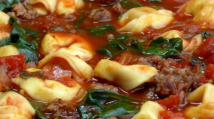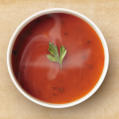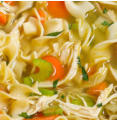
Soup Recipes
Home | Indian Recipes | Thai Recipes | Main Dishes | Desserts | Leave a Comment | Recipes by Email | About
Copyright © Suzanne’s Recipe File | Privacy Policy

Through all of food history, soups have served as easy and economical way to get the most out of meats
and vegetables. Soups are basically a mixture of water or other liquids with solid ingredients. The boiling of
bones of leftover meats is an easy way to extract every last bit of flavor and nourishment. Putting vegetables
into the soup pot adds other flavors and nutrients that meat alone cannot provide.
►Home- All Recipes
►Soup Recipes
►Chicken Noodle
Soup
►Tortilini Beef
Soup
►Vegtarian Gumbo
►Vegetable Soup
►Butternut Squash
Soup
►Split Pea Soup
►French Onion
Soup
►New England
Corn Chowder
►Thai Lemongrass
Soup
►Tomato Soup
►Leave a Comment
►Get Recipes by
Email
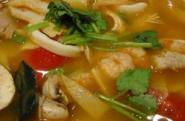
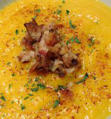
Although there are hundreds of kinds of soups, they all mostly fall into two main categories: thin and
thick soups. The thin soups are basically clear broths (bouillon, stock) and the more concentrated
consommés. Thick soups are classified by the ingredient that serves as the thickener like cream, eggs or
butter, rice, flour, grain or even pureed vegetables or shellfish. Stews are closely related to soups but are
much thicker and contain less liquid.
Since the 1800’s, science and industrialization have given us dehydrated and canned
soups, but there is nothing like a good home made soup – I think their taste is amazingly much
better.
Here are some different categories of soups and the basic ingredients that define them:
Borscht – made from beets, which were popular among poorer people of eastern Europe
and Russia.
Chowder – a New England, USA, seafood (mostly clam) and potato soup usually
thickened with
cream or milk.
Bisque – a thick cream soup that starts out with pureed shellfish, fruit or vegetables.
Gazpacho – a cold tomato based soup with Spanish origins, usually all vegetarian.
Vichyssoise – another chilled soup thickened with cream and potatoes flavored with leeks.
Goulash – a Hungarian soup, containing paprika of course, thick with beef leftovers.
Noodle soups – clear chicken broth with egg noodles is a timeless classic.
Meat and vegetable soups – beef or chicken meat and bones boiled with vegetables to
make a clear broth.
Potages – meat and vegetables boiled to make a thick mush.
Fermented soups – like Miso soup, the traditional Japanese soup made from fermented
rice, barley or soybeans
Fruit soups – warm or cold, usually found in cuisines of Scandinavia, Eastern Europe,
Middle East and Asia
Purees – based on a pureed starchy vegetables like potatoes
Vegetarian – with no animal gelatins for a thickening, these delicious soups instead use
tomatoes, rice, potatoes or bread as thickeners.
My favorite soup recipe is for my home made Chicken Noodle Soup. I really feel like I am
getting my money’s worth from a roast chicken when I “recycle” the chicken bones to make this
delicious soup. The secret is to add the dried noodles directly to the soup without cooking them
separately. That way, the noodles don’t taste watery because they soak up the delicious
chicken flavored broth.
From my mother in law comes a recipe for New England corn chowder, a vegetarian soup with no
seafood or meat added. This is a real winner of a recipe that my family loves to have during cold weather. Be
careful about stirring this soup since it has so much milk it can scald easily.
I first learned how to make Thai shrimp and lemongrass soup in a restaurant cooking class. I was
surprised how boiling just shrimp shells could make such a flavorful broth. The real secret to this soup is the
chili paste in soy bean oil (Nam Prik Pao in Thai) so if you do not have an Asian grocery nearby you can try
ordering this necessary ingredient online. For the lemongrass you can use some lemon juice in a pinch but for
the chili paste there is no substitute. Try it - it is worth it.
All of my soup recipes are linked on the left side of this page – just pick one to try!


